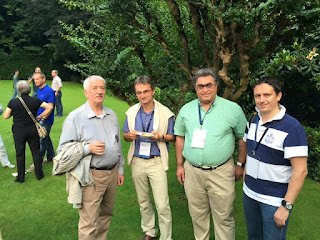This blog post is also available at at blog.timmerer.com and SIGMM records.
The 112th MPEG meeting in Warsaw, Poland was a special meeting for me. It was my 50th MPEG meeting, which roughly equates to one year of MPEG meetings (i.e., I’ve spent one year of my life in MPEG meetings incl. traveling – scary, isn’t it? … more on this in another blog post). But what happened at this 112th MPEG meeting (my 50th meeting)…
- Requirements: CDVA, Future of Video Coding Standardization (no acronym yet), Genome compression
- Systems: M2TS (ISO/IEC 13818-1:2015), DASH 3rd edition, Media Orchestration (no acronym yet), TRUFFLE
- Video/JCT-VC/JCT-3D: MPEG-4 AVC, Future Video Coding, HDR, SCC
- Audio: 3D audio
- 3DG: PCC, MIoT, Wearable

As usual, the official press release and other publicly available documents can be found here. Let’s dig into the different subgroups:
Requirements
In requirements, experts were working on the Call for Proposals (CfP) for Compact Descriptors for Video Analysis (CDVA) including an evaluation framework. The evaluation framework includes 800-1,000 objects (large objects like building facades, landmarks, etc.; small(er) objects like paintings, books, statues, etc.; scenes such as interior scenes, natural scenes, multi-camera shots) and the evaluation of the responses should be conducted for the 114th meeting in San Diego.
The future of video coding standardization is currently happening in MPEG and shaping the way for the successor of of the HEVC standard. The current goal is to provide (native) support for scalability (more than two spatial resolutions) and 30% compression gain for some applications (requiring a limited increase in decoder complexity) but actually 50% compression gain is preferred (at a significant increase of the encoder complexity). MPEG will hold a workshop at the next meeting in Geneva to discuss specific compression techniques, objective (HDR) video quality metrics, and compression technologies for specific applications (e.g., multiple-stream representations, energy-saving encoders/decoders, games, drones). The current goal is to have the International Standard for this new video coding standard by around 2020.
MPEG has recently started a new project referred to as Genome Compression which is of course about the compression of genome information. A big dataset has been collected and experts are working on the Call for Evidence (CfE). The plan is to hold a workshop at the next MPEG meeting in Geneva regarding prospect of Genome Compression and Storage Standardization targeting users, manufactures, service providers, technologists, etc.

Systems
The 5th edition of the MPEG-2 Systems standard was published as ISO/IEC 13818-1:2015 on the 1st of July 2015 and is a consolidation of the 4th edition + Amendments 1-5.
In terms of MPEG-DASH, the draft text of ISO/IEC 23009-1 3rd edition comprising 2nd edition + COR 1 + AMD 1 + AMD 2 + AMD 3 + COR 2 is available for committee internal review. The expected publication date is scheduled for, most likely, 2016. Currently, MPEG-DASH includes a lot of activity in the following areas: spatial relationship description, generalized URL parameters, authentication, access control, multiple MPDs, full duplex protocols (aka HTTP/2 etc.), advanced and generalized HTTP feedback information, and various core experiments:
- SAND (Sever and Network Assisted DASH)
- FDH (Full Duplex DASH)
- SAP-Independent Segment Signaling (SISSI)
- URI Signing for DASH
- Content Aggregation and Playback COntrol (CAPCO)
In particular, the core experiment process is very open, as most work is conducted during the Ad hoc Group (AhG) period which is discussed on the publicly available MPEG-DASH reflector.
MPEG systems recently started an activity that is related to media orchestration which applies to capture as well as consumption and concerns scenarios with multiple sensors as well as multiple rendering devices, including one-to-many and many-to-one scenarios resulting in a worthwhile, customized experience.
Finally, the systems subgroup started an exploration activity regarding real-time streaming of file (a.k.a TRUFFLE) which should perform a gap analysis leading to extensions of the MPEG Media Transport (MMT) standard. However, some experts within MPEG concluded that most/all use cases identified within this activity could actually be solved with existing technology such as DASH. Thus, this activity may still need some discussion…
Video/JCT-VC/JCT-3D
The MPEG video subgroup is working towards a new amendment for the MPEG-4 AVC standard covering resolutions up to 8K and higher frame rates for lower resolution. Interestingly, although MPEG is ahead of industry most of the time, 8K and high frame rate is already supported in browser environments (e.g., using bitdash 8K, HFR) and modern encoding platforms such as bitcodin (now known as Bitmovin Encoding Service). However, it’s good that we finally have means for an interoperable signaling of this profile.
In terms of future video coding standardization, the video subgroup issued a call for test material. Two sets of test sequences are already available and will be investigated regarding compression by the next meeting.
After a successful call for evidence for High Dynamic Range (HDR), the technical work starts in the video subgroup with the goal to develop an architecture (“H2M”) as well as three core experiments (optimization without HEVC specification change, alternative reconstruction approaches, objective metrics).
The main topic of the JCT-VC was screen content coding (SCC) which came up with new coding tools that are better compressing content that is (fully or partially) computer generated, leading to a significant improvement of compression, approx. 50% rate reduction or larger, for specific screen content.
Audio
The audio subgroup is mainly concentrating on 3D audio where they identified the need for intermediate bitrates between 3D audio phase 1 and 2. Currently, phase 1 identified 256, 512, 1200 kb/s whereas phase 2 focuses on 128, 96, 64, 48 kb/s. The broadcasting industry needs intermediate bitrates and, thus, phase 2 is extended to bitrates between 128 and 256 kb/s.
3DG
MPEG 3DG is working on point cloud compression (PCC) for which open source software has been identified. Additionally, there’re new activity in the area of Media Internet of Things (MIoT) and wearable computing (like glasses and watches) that could lead to new standards developed within MPEG. Therefore, stay tuned on these topics as they may shape your future.
The week after the MPEG meeting I met the MPEG convenor and the JPEG convenor again during ICME2015 in Torino but that’s another story…

Follow Christian on Twitter: @timse7
Follow Bitmovin on Twitter: @bitmovin




